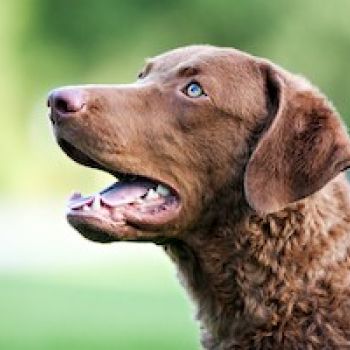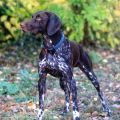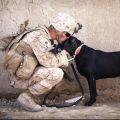The Chesapeake Bay Retriever, often referred to as the Chessie, is a remarkable and versatile breed known for its exceptional water retrieving abilities. With a rugged and muscular build, this breed is well-suited for various tasks, making it a popular choice among hunters, waterfowlers, and outdoor enthusiasts. The Chesapeake Bay Retriever is a breed that embodies strength, intelligence, and loyalty, making it an ideal companion for those who lead an active lifestyle.
Originating from the Chesapeake Bay region in the United States during the 19th century, the Chesapeake Bay Retriever was developed to withstand the harsh and icy waters of the bay. It is believed that the breed's ancestors were brought to the region by English and Irish sailors, who crossed their dogs with local retrievers to create a breed capable of retrieving waterfowl in the challenging conditions of the Chesapeake Bay.
According to the FCI (Fédération Cynologique Internationale) typology, the Chesapeake Bay Retriever belongs to Group 8: Retrievers, Flushing Dogs, and Water Dogs. This group includes breeds that excel in retrieving game from land or water. Within this group, the Chessie is classified under Section 1: Retrievers, which comprises breeds specifically developed for retrieving game in water.
The Chesapeake Bay Retriever is primarily a working breed, known for its exceptional hunting and retrieving skills. These dogs are highly valued for their ability to retrieve waterfowl, making them a favorite among hunters and waterfowlers. However, their intelligence and trainability also make them suitable for various dog sports, such as obedience, agility, and tracking. Additionally, their loyal and protective nature makes them excellent family companions and watchdogs.
In terms of physical characteristics, the Chesapeake Bay Retriever is a medium to large-sized breed. Males typically stand between 23 to 26 inches (58 to 66 cm) at the shoulder, while females are slightly smaller, ranging from 21 to 24 inches (53 to 61 cm). The breed's weight varies between 55 to 80 pounds (25 to 36 kg) for males and 45 to 70 pounds (20 to 32 kg) for females.
One notable feature of the Chesapeake Bay Retriever is its distinctive coat, which consists of a dense, short, and oily double coat. This unique coat provides excellent insulation and protection against the cold waters of the Chesapeake Bay. The breed's coat color can vary, but the most common colors are shades of brown, ranging from light to dark, with or without white markings on the chest and feet.
The Chesapeake Bay Retriever has a life expectancy of around 10 to 12 years. Like many large breeds, they are prone to certain health issues, including hip dysplasia, progressive retinal atrophy, and various joint problems. Regular exercise, a balanced diet, and routine veterinary care are essential for maintaining their overall health and well-being.
Despite their working background, Chesapeake Bay Retrievers are known for their gentle and affectionate nature. They form strong bonds with their families and are particularly good with children. However, early socialization and training are crucial to ensure they develop into well-rounded and obedient companions.
In addition to their exceptional retrieving abilities, Chesapeake Bay Retrievers are also known for their remarkable scenting skills. They have an incredible sense of smell, which makes them excellent search and rescue dogs, as well as detection dogs for various purposes, including narcotics and explosives.
In conclusion, the Chesapeake Bay Retriever is a remarkable breed with a rich history and exceptional working abilities. Their strength, intelligence, and loyalty make them highly sought after by hunters, waterfowlers, and outdoor enthusiasts. With proper training, socialization, and care, these dogs can also thrive as loving family companions. Whether in the field or at home, the Chesapeake Bay Retriever is a breed that continues to impress with its versatility and unwavering devotion.
The Chesapeake Bay Retriever, also known as the Chessie, is a remarkable breed of dog with a unique character that sets them apart from other retrievers. With their distinctive appearance and exceptional abilities, Chessies have become a favorite among dog enthusiasts and hunters alike. This comprehensive description will delve into their character, behavior, and provide insights on how to raise and train these magnificent dogs.
Character:
Chesapeake Bay Retrievers are known for their strong-willed and independent nature. They possess a remarkable sense of loyalty and devotion towards their family, making them excellent companions and protectors. Chessies are intelligent, confident, and possess a strong work ethic, which makes them highly trainable and versatile in various tasks.
Behavior:
One of the defining characteristics of Chesapeake Bay Retrievers is their love for water. Bred to retrieve waterfowl in the harsh conditions of the Chesapeake Bay, these dogs have a natural affinity for swimming and are exceptional swimmers. Their thick, oily double coat provides insulation and protection against cold water, making them well-suited for retrieving in challenging environments.
While Chessies are generally friendly and good-natured, they can be reserved and aloof with strangers. This inherent wariness towards unfamiliar people makes them excellent watchdogs. However, early socialization is crucial to ensure they develop into well-rounded dogs who can differentiate between friend and foe.
Raising Chesapeake Bay Retrievers:
When raising a Chesapeake Bay Retriever, it is important to provide them with plenty of mental and physical stimulation. These dogs have an abundance of energy and require regular exercise to keep them happy and healthy. Long walks, swimming sessions, and engaging playtime are essential to prevent boredom and destructive behavior.
Due to their independent nature, Chessies may exhibit stubbornness at times. Consistency, patience, and positive reinforcement training methods work best with this breed. Early obedience training and socialization are vital to ensure they grow into well-behaved and well-adjusted dogs.
Training Chesapeake Bay Retrievers:
Chesapeake Bay Retrievers excel in various activities, including obedience, agility, tracking, and of course, retrieving. Their intelligence and eagerness to please make them quick learners. However, they can be sensitive to harsh training methods, so it is crucial to use positive reinforcement techniques such as treats, praise, and rewards.
Start training your Chessie from an early age, focusing on basic commands like sit, stay, and recall. As they mature, you can gradually introduce more advanced training exercises. Consistency, repetition, and short training sessions will yield the best results.
In conclusion, Chesapeake Bay Retrievers are remarkable dogs with a character that sets them apart. Their loyalty, intelligence, and love for water make them exceptional companions and working dogs. Raising and training a Chessie requires dedication, patience, and a firm yet gentle approach. With proper care, socialization, and training, these dogs will thrive and bring joy to their families for many years to come.
The Chesapeake Bay Retriever, also known as the Chessie, is a strong and intelligent breed that requires specific care to ensure their well-being. Here are some tips on how to care for Chesapeake Bay Retrievers, including what to do and what not to do:
1. Exercise: Chessies are active dogs that require regular exercise to keep them physically and mentally stimulated. Aim for at least 60 minutes of exercise daily, which can include walks, runs, swimming, or playing fetch. However, avoid excessive exercise in hot weather to prevent overheating.
2. Grooming: Chesapeake Bay Retrievers have a dense double coat that requires regular brushing to prevent matting and to remove loose hair. Brush them at least once a week, and during shedding seasons, increase it to two or three times a week. Bathing should be done only when necessary to avoid stripping natural oils from their coat.
3. Training: Chessies are highly intelligent and trainable, but they can be independent and stubborn at times. Start training early and use positive reinforcement techniques such as treats and praise. Consistency and patience are key to successful training. Socialization is also crucial to prevent any potential aggression or shyness.
4. Mental Stimulation: Chessies have an active mind and need mental stimulation to prevent boredom and destructive behaviors. Provide puzzle toys, interactive games, and training sessions to keep their minds engaged. They excel in activities like obedience, agility, and tracking.
5. Nutrition: Feed your Chesapeake Bay Retriever a high-quality dog food that meets their specific nutritional needs. Consult with your veterinarian to determine the appropriate portion size and feeding schedule based on their age, weight, and activity level. Avoid overfeeding to prevent obesity, which can lead to various health issues.
6. Health Care: Regular veterinary check-ups are essential to ensure your Chessie's overall health. Vaccinations, parasite prevention, and dental care should be part of their routine. Chesapeake Bay Retrievers are prone to certain health conditions like hip dysplasia, progressive retinal atrophy, and allergies. Regular exercise, a balanced diet, and maintaining a healthy weight can help minimize the risk of these issues.
7. Safety: Chessies are known for their love of water, but not all of them are natural swimmers. Always supervise them near water bodies to prevent accidents. Secure your yard with a sturdy fence to keep them from wandering off, as they have a tendency to explore. Avoid leaving them alone for extended periods as they thrive on human companionship.
8. Weather Considerations: Chesapeake Bay Retrievers have a thick coat that provides insulation in cold weather, but they can be sensitive to extreme temperatures. In hot weather, provide shade, fresh water, and avoid exercising during the hottest parts of the day. In cold weather, consider using doggy sweaters or jackets to keep them warm during walks.
What not to do:
1. Do not neglect their exercise needs. Lack of physical activity can lead to behavioral issues and obesity.
2. Do not use harsh training methods or punishment. This breed responds best to positive reinforcement techniques.
3. Do not overfeed or give excessive treats. Obesity can lead to various health problems, including joint issues.
4. Do not leave them alone for long periods. Chesapeake Bay Retrievers thrive on human companionship and can develop separation anxiety if left alone for extended periods.
5. Do not skip regular veterinary check-ups. Early detection of health issues can lead to better treatment outcomes.
By following these care tips and avoiding common mistakes, you can provide your Chesapeake Bay Retriever with a happy, healthy, and fulfilling life.
The Chesapeake Bay Retriever, a breed known for its exceptional hunting and retrieving abilities, possesses a unique and captivating coat color that is distinctively characteristic of the breed. The common color of Chesapeake Bay Retrievers is a rich and lustrous shade of brown, often referred to as "deadgrass" or "sedge."
The deadgrass coloration of Chesapeake Bay Retrievers is a result of their adaptation to the environment in which they were originally bred. These dogs were developed to withstand the harsh conditions of the Chesapeake Bay region, where they were primarily utilized for retrieving waterfowl. The brown color of their coat serves as excellent camouflage, allowing them to blend seamlessly into the marshy landscapes and reed-filled wetlands.
The deadgrass color is not a uniform shade of brown but rather a complex blend of various tones and hues. The base color can range from a warm, reddish-brown to a deep, chocolate brown. The coat often exhibits subtle variations in color, with lighter and darker patches distributed throughout. These variations add depth and dimension to the overall appearance of the dog, enhancing its natural beauty.
The texture of the Chesapeake Bay Retriever's coat is another noteworthy feature. It is dense, thick, and waterproof, providing excellent insulation and protection against the elements. This unique coat texture enables the dog to withstand cold water temperatures and harsh weather conditions, making it an ideal companion for waterfowl hunting.
In addition to the deadgrass color, Chesapeake Bay Retrievers may also have small white markings on their chest, toes, or tail tip. These markings, although minimal, add a touch of contrast to the overall appearance of the dog, further accentuating its striking coloration.
The deadgrass color of Chesapeake Bay Retrievers is not only visually appealing but also serves a functional purpose. It allows these dogs to blend seamlessly into their natural surroundings, making them highly effective hunters and retrievers. This coloration, combined with their sturdy build and powerful swimming abilities, makes them well-suited for their original purpose as waterfowl retrievers.
In conclusion, the common color of Chesapeake Bay Retrievers is a captivating shade of brown known as deadgrass or sedge. This rich and lustrous coat color, with its complex blend of tones and hues, provides excellent camouflage and enhances the dog's natural beauty. Coupled with their dense and waterproof coat texture, Chesapeake Bay Retrievers are not only visually striking but also well-equipped for their role as skilled hunters and retrievers in the Chesapeake Bay region.
The Chesapeake Bay Retriever, also known as the Chessie, is a robust and hardy breed known for its exceptional water retrieving abilities. With a lifespan of 10-12 years, these dogs are generally healthy, but like any breed, they are prone to certain health issues. To ensure the well-being of your Chesapeake Bay Retriever, it is crucial to understand the common diseases they may face and how to care for their overall health.
One of the most prevalent health concerns in Chesapeake Bay Retrievers is hip dysplasia. This genetic condition occurs when the hip joint does not develop properly, leading to joint instability and subsequent arthritis. Regular exercise, maintaining a healthy weight, and avoiding excessive jumping or rough play during the puppy stage can help reduce the risk of hip dysplasia. Additionally, responsible breeders conduct hip evaluations on their breeding dogs to minimize the occurrence of this condition.
Another common health issue in Chessies is progressive retinal atrophy (PRA). PRA is a degenerative eye disease that leads to gradual vision loss and, in severe cases, blindness. Regular eye examinations by a veterinary ophthalmologist can help detect PRA early on, allowing for appropriate management and lifestyle adjustments to ensure the dog's quality of life.
Chesapeake Bay Retrievers are also prone to various skin conditions, including allergies, hot spots, and bacterial or fungal infections. Regular grooming, including brushing their dense double coat to prevent matting, is essential. Bathing should be done as needed, using a gentle dog-specific shampoo to avoid stripping the natural oils from their skin. Regularly inspecting their ears and cleaning them with a veterinarian-recommended solution can help prevent ear infections, which are common in Chessies due to their floppy ears.
Like many large breeds, Chesapeake Bay Retrievers are susceptible to bloat, also known as gastric dilatation-volvulus (GDV). This life-threatening condition occurs when the stomach fills with gas and twists on itself. Feeding multiple small meals throughout the day, avoiding exercise immediately after meals, and using elevated feeding bowls can help reduce the risk of bloat. If you notice symptoms such as restlessness, unproductive vomiting, or a distended abdomen, seek immediate veterinary attention.
To maintain the overall health of your Chesapeake Bay Retriever, a balanced diet is crucial. Providing high-quality dog food that meets their nutritional needs, including appropriate levels of protein, fat, and carbohydrates, is essential. Regular exercise, such as swimming or long walks, helps keep them physically fit and mentally stimulated. Mental stimulation is equally important, as Chessies are intelligent dogs that thrive on mental challenges and tasks.
Regular veterinary check-ups are vital for early detection of any health issues. Vaccinations, parasite prevention, and dental care should be part of their routine healthcare. Additionally, maintaining a healthy weight through portion control and avoiding excessive treats can help prevent obesity, which can lead to various health problems.
In conclusion, while Chesapeake Bay Retrievers are generally healthy dogs, they are prone to certain conditions such as hip dysplasia, PRA, skin issues, and bloat. By being proactive in their care, including regular exercise, proper grooming, a balanced diet, and routine veterinary check-ups, you can ensure the health and well-being of your Chesapeake Bay Retriever for years to come.
The Chesapeake Bay Retriever is a strong and active breed known for its exceptional hunting and retrieving abilities. To ensure their overall health and well-being, it is crucial to provide them with a well-balanced and nutritious diet. Proper nutrition plays a vital role in maintaining their energy levels, promoting healthy growth, and preventing potential health issues. Here is an extensive description of the nutrition requirements for Chesapeake Bay Retrievers, along with advice on feeding and what to avoid.
Protein is an essential component of a Chesapeake Bay Retriever's diet. It aids in muscle development, repair, and overall growth. High-quality animal-based proteins such as chicken, turkey, beef, and fish should be the primary source of protein in their diet. Look for dog food that lists these protein sources as the first ingredients. Avoid foods that contain excessive amounts of fillers, by-products, or artificial additives.
Fats are another crucial element in a Chesapeake Bay Retriever's diet. They provide a concentrated source of energy and help maintain healthy skin and coat. Look for dog food that contains healthy fats like fish oil, flaxseed oil, or chicken fat. These fats also aid in the absorption of fat-soluble vitamins.
Carbohydrates are a source of energy for dogs, but it's important to choose complex carbohydrates over simple ones. Whole grains like brown rice, oats, and barley are excellent choices. Avoid foods that contain excessive amounts of corn, wheat, or soy, as these can cause allergies or digestive issues in some dogs.
Fruits and vegetables are essential for providing vitamins, minerals, and antioxidants. They also add fiber to the diet, aiding in digestion. Incorporate a variety of fruits and vegetables into your Chesapeake Bay Retriever's diet, such as carrots, sweet potatoes, blueberries, and spinach. However, avoid feeding them grapes, raisins, onions, or garlic, as these can be toxic to dogs.
Feeding guidelines for Chesapeake Bay Retrievers vary depending on their age, activity level, and overall health. Puppies require more frequent meals, typically three to four times a day, while adult dogs can be fed twice a day. It's important to monitor their weight and adjust the portion sizes accordingly to prevent obesity.
Avoid overfeeding your Chesapeake Bay Retriever, as they have a tendency to gain weight easily. Obesity can lead to various health issues, including joint problems and heart disease. If you notice your dog gaining weight, consult with your veterinarian to determine the appropriate portion sizes and feeding schedule.
In addition to a balanced diet, fresh water should always be available for your Chesapeake Bay Retriever. Hydration is crucial for their overall health and helps maintain proper organ function.
Lastly, regular exercise is essential for Chesapeake Bay Retrievers to maintain a healthy weight and overall well-being. A combination of physical exercise and mental stimulation is necessary to keep them happy and prevent behavioral issues.
In conclusion, providing a well-balanced and nutritious diet is vital for the health and longevity of Chesapeake Bay Retrievers. Focus on high-quality proteins, healthy fats, complex carbohydrates, and a variety of fruits and vegetables. Avoid foods with excessive fillers, by-products, or artificial additives. Monitor portion sizes, avoid overfeeding, and provide regular exercise. By following these guidelines, you can ensure that your Chesapeake Bay Retriever thrives and enjoys a healthy and active life.





